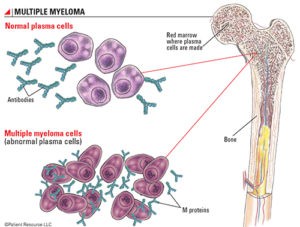for patients with high-risk MM who have a poor long-term prognosis, allo-SCT may be a strong consideration in their initial course of therapy or in first relapse after chemotherapy
I am a long-term MM survivor. I live in a world of long-term and late stage side effects from my aggressive MM treatments in 1995. Because of this, I have a difficult time with oncologists using terms like “curative potential” for allogeneic transplantation for multiple myeloma for high-risk MM. Let me explain why I feel this way.

First and foremost, a diagnosis of an incurable cancer like MM is beyond difficult. If your oncologist presents a therapy that has “curative potential” the MMer can’t help but consider it. I understand the difficult situation that newly diagnosed MMers are in. The key, in my opinion, is informed consent. To start down the road to informed consent, you must first ask your oncologist if any MM has ever been cured by an allogeneic transplant.
Secondly, the MM must try to understand the risks of aggressive therapy like an allogeneic transplant as fully as possible.
Some of the transplant-related risks discussed below are as follows:
- more than 10% of all patients will die from the side-effects of their allo transplant in the first 100 days-
- about a fifth of all patients will die from the side-effects of their allo transplant eventually-
- more than half of all patients will live with GVHD for the rest of their lives-
Acute and chronic graft vs. host disease can must be understood to achieve informed consent. While each newly diagnosed MMer must make his/her own treatment decisions, it’s important to point out that conventional MM oncology presents one of many different perspectives.
To learn more about perspectives beyond conventional MM oncology, scroll down the page, post a question or comment and I will reply to you ASAP.
Thank you,
David Emerson
- MM Survivor
- MM Cancer Coach
- Director PeopleBeatingCancer
Recommended Reading:
“Despite recent advances, multiple myeloma (MM) remains incurable. However, the appearance of allogeneic stem cell transplantation (allo-SCT) through graft-versus-myeloma effect provides a potential way to cure MM to some degree. This systematic review aimed to evaluate the outcome of patients receiving allo-SCT and identified a series of prognostic factors that may affect the outcome of allo-SCT…
We systematically searched PubMed, Embase, and the Cochrane Library from 2007.01.01 to 2017.05.03 using the keywords ‘allogeneic’ and ‘myeloma’…
A total of 61 clinical trials involving 8698 adult patients were included. The pooled estimates
- for overall survival (OS) at 1, 2, 3 and 5 years were 70, 62, 52, and 46, respectively;
- for progression-free survival were 51, 40, 34, and 27, respectively;
- and for treatment-related mortality (TRM) were 18, 21, 20, and 27, respectively.
Additionally, the pooled 100-day Treatment-Related Mortality was 12.
The incidences of grades II–IV acute graft-versus-host disease (GVHD) and chronic GVHD were 34 and 51, respectively.
The incidences of relapse rate (RR) and death rate were 50 and 51, respectively.
Importantly, disease progression was the most major cause of death (48%), followed by TRM (44%). The results failed to show an apparent benefit of allo-SCT for standard risk patients, compared with tandem auto-SCT.
In contrast, all 14 trials in our study showed that patients with high cytogenetic risk after allo-SCT had similar OS and PFS compared to those with standard risk, suggesting that allo-SCT may overcome the adverse prognosis of high cytogenetic risk…
Conclusion-Due to the lack of consistent survival benefit, allo-SCT should not be considered as a standard of care for newly diagnosed and relapsed standard-risk MM patients. However, for patients with high-risk MM who have a poor long-term prognosis, allo-SCT may be a strong consideration in their initial course of therapy or in first relapse after chemotherapy, when the risk of disease progression may outweigh the transplant-related risks. A large number of prospective randomized controlled trials were needed to prove the benefits of these therapeutic options.”
“Although a reasonable and often curative treatment option, use of allogeneic hematopoietic stem cell therapy (HSCT) in relapsed multiple myeloma still tends to fall under the radar, according to Sergio A. Giralt, M.D.
The procedure, which has been around for more than two decades, is the only therapeutic strategy that has demonstrated curative potential in patients who relapse after primary therapy, added Giralt…
“Allogeneic HSCT is a valid option and it should not be automatically dismissed just because it has been available for 20 years,” he explained in an interview with CURE’s sister publication, OncLive. “We are the first to recognize that results are not what we want them to be. However, there are a number of innovative clinical trials exploring allogeneic HSCT that will hopefully improve outcomes for these patients. More importantly, for a young patient with multiple-relapsed disease, allogeneic HSCT offers a chance for disease control.”
In the relapsed setting, the Food and Drug Administration has approved 10 agents to treat multiple myeloma, which has led to much debate over the standard of care for these patients.
However, Giralt recommended for patients and their providers to consider allogeneic HSCT – not only because of its veteran status among the various treatment options, but also because it is associated with chances for long-term disease control or clinical benefit. “The results have also improved dramatically over the last few years, and it should be considered a valid therapeutic option for young patients with relapsed disease [that has relapsed multiple times],” he added. “It can even be considered as part of upfront treatment for young patients with high-risk disease…”




